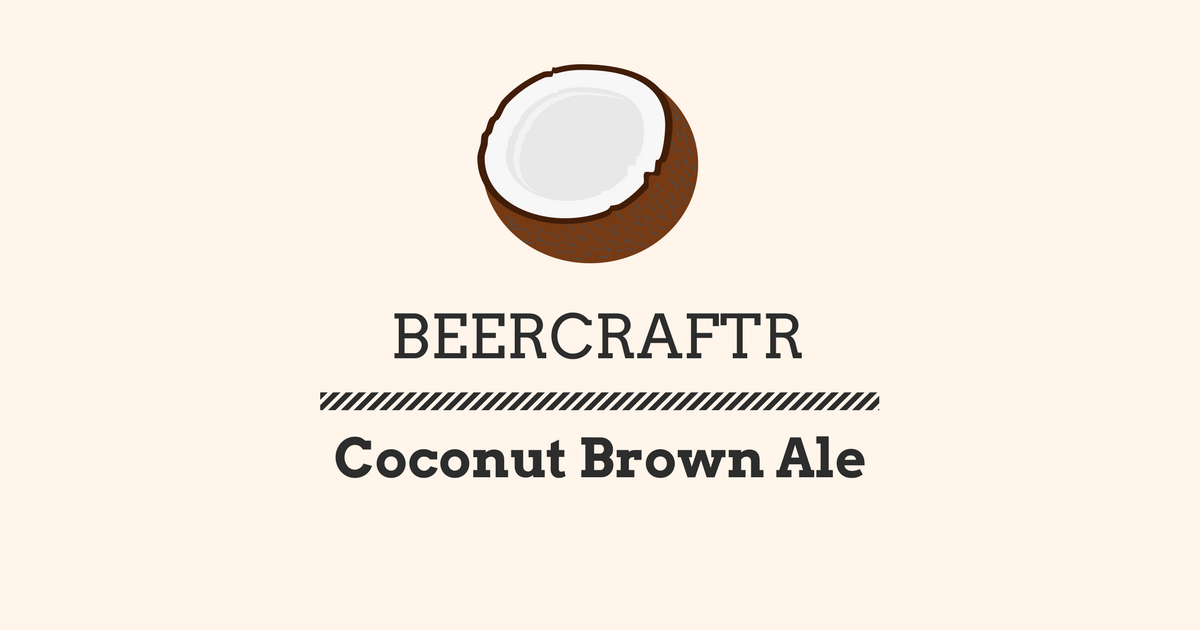
Two of my closest friends celebrated their wedding in summer 2017, and I wanted to toast them with a beer they could call their own. They had recently spent a week in Asheville, North Carolina and raved about the coconut brown ales (and porters) that brew mecca had on offer. So, I thought, why not make them their own version? This is it, and it’s worth the extra effort. I originally had to brew a larger batch; this one is the scaled down version for 1-gallon brewing.
I have some additional notes for this recipe:
I toasted the coconut chips manually. I recommend taking this extra step. You’ll get a fresher roast, and you control how much flavour you add to the final brew. Spread the coconut chips on a cookie sheet and bake at 325ºF for 5-10 minutes, keeping a close eye on it; it can burn quickly.
On bottling day, you want to create a bottling solution that has been infused with coconut. To make the coconut solution, steep 45 g of un-toasted coconut chips in 750ml of just-off-the-boil water, for 20 minutes. Strain out the chips, add your priming sugar, bring back to the boil for at least 10 minutes, or as long as it takes to get down to 185 ml of priming solution.
Recipe Profile
- Method: 1 gallon BIAB (Brew-in-a-bag), single stage
- Target OG (Original Gravity): 1.051
- Target FG (Final Gravity): 1.014
- Bitterness (IBUs): 28
- Estimated ABV: 4.8%
- Boil: 60 minutes
Ingredients
- 1.75 lbs Pale Malt (2-Row)
- 4 oz Crystal Malt (60L)
- 2 oz Chocolate Malt
- 2 oz Victory Malt
- 0.25 lbs toasted coconut chips
- 0.20 oz Northern Brewer Hops at 60 minutes
- 0.25 lbs toasted coconut chips at 10 minutes
- American Ale Yeast (Wyeast 1056)
The Mash
- Bring 9 litres of water to a temperature of 163°F. Add your grains and give everything a good stir until the whole thing looks a bit like oatmeal. Shut off the heat, cover with a lid, and let it steep at 156°F for 60 minutes.
- Then you need to “mash out.” You put the heat back on, and raise the temperature to 168°F (75.6°C) and keep stirring for 7 minutes.
- Remove the grains and prepare for the boil. If you’re using a bag, just pull it out and let it drip near-dry above the pot. If you’re using a colander, strain to remove the grains, preserving the wort, which you’ll add back to the pot.
- Check that your gravity is on track and correct it if needed. You need 66 gravity points for this recipe, as our target post-boil volume is 1.3 gallons.
The Boil
- Start the boil by bringing your wort up to a boil. Once boiling, start your timer. Add your bittering hops, as prescribed above.
- Meanwhile, prepare your sanitizer solution.
- Just before the boil is complete, make an ice bath in your kitchen sink. Load it up with as much ice and cold water as you can. Once the boil is over, transfer your pot to the sink to cool your wort to pitching temperature, as prescribed on the yeast pack. Remember to sanitize your thermometer every time you check the temperature.
- Meanwhile, thoroughly clean and sanitize your carboy, screw cap, airlock, funnel, and strainer/colander. You want everything to be ready to go once the wort is at the right temperature.
- Once the wort is at pitching temperature, transfer it to the carboy by passing it through a strainer overtop the funnel.
- Aerate the wort. Cover the fermenter with a screw cap and gently rock the carboy back and forth for a few minutes to mix in some air.
- Pitch the yeast! Use sanitized scissors to cut open the package and pour in the yeast.
- Seal the carboy by filling the airlock with sanitizer. Fit it in the screw cap. Move the carboy to a dark spot, free of the home’s daily commotion for at least 14 days (but ideally not more than 21).
Bottling Day
- Move the carboy to the countertop, if it wasn’t already there. If the wort got lots of movement during transfer, let it sit so that any stirred-up yeast has a chance to re-settle.
- Sanitize everything that will come in contact with the beer: bottling bucket, auto-siphon, tubing, filler, bottles, and bottle caps.
- Dissolve 0.59 oz (17g) corn sugar in enough boiling water to dissolve it. Add the dissolved sugar solution to your sanitized bottling bucket.
- Fill your auto-siphon and hose with sanitizer before submerging in the carboy. Transfer the solution to a spare container until the beer has completely replaced all the sanitizer in the tubes. Now you can place the end with the bottle filler in the bottling bucket, which should also be on the floor and gently transfer the beer from the carboy to the bucket.
- Transfer all the liquid up and the point where it reaches the sediment. Leave the sediment in the carboy.
- Now, move the bottling bucket to the counter and siphon the beer quietly into each bottle. When the liquid gets to the very top of the bottle, remove the bottle filler, which will leave the perfect amount of headspace at the top of the bottle.
- Cover each bottle with the sanitized caps and cap them into place, or secure your sanitized swing-top caps if using those.
- Store the bottles upright in a quiet, dark corner at 65F (18.5C) or so.
- Wait 30 days, if you can. If you’re way too curious (I can’t blame you!) try and hold out for 14 days. If you absolutely can’t wait, you can try after 7 days, but the beer really needs at least 14 days to condition.

Leave a Reply